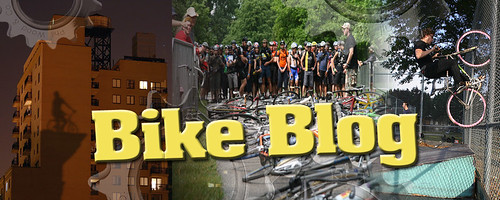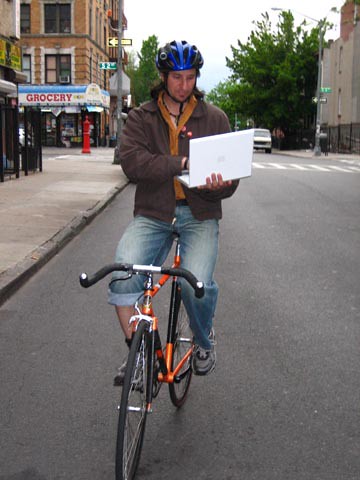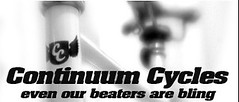Article about May Critical Mass
It looks like the villager newspaper has found it's news worthy niche. The battle to ride your bike in New York City.
Once again they submit a lengthy article on the subject of last month's critical mass.
If only other newspapers more widely circulated gave half as much attention to this civil rights issue as the villager.
Oh well, its a start.
Read on:
Title of article:
Mass goes to church, senses grace
period from police
By Lincoln Anderson
Closing in on the one-year mark in the city’s crackdown against Critical Mass, last Friday night’s monthly bicycle ride was one of the most lightly policed since the one before the Republican National Convention, when the arrests began.
At last month’s ride, the police presence around Union Sq. at the ride’s start was very high. Last Friday it was almost nil. A small knot of officers stood near the Washington statue casually chatting, as speakers, including Stanley Aronowitz, Norman Siegel, Councilmember Gale Brewer and Reverend Billy, trumpeted bikers’ rights. A few people in the crowd angrily objected, though, to an officer posted on the roof of Zeckendorf Towers who was surveilling the scene.
“Those streets are ours!” said Aronowitz, a CUNY professor who ran for governor as a Green three years ago. Aronowitz called for a total ban on cars in Manhattan, then modified this to a 6 a.m.- 6 p.m. ban allowing only bicycles, buses and taxis. “Mexico City, which is a Third World city, has restrictions on automobiles — and look at our city,” he said. It won’t be easy, he said: people will have to stand up to “the trucking companies, Wall St. and the tour buses” to get autos off the streets.
“I love bikes and I don’t love cars,” Brewer, who represents the Upper West Side, told the crowd. “I look forward to working with you to make sure there are fewer cars and more bicycles.”
“The struggle continues,” said civil rights attorney Siegel, noting more than 500 people have been arrested for bicycle riding since last August, mostly in Critical Mass. A candidate for public advocate, Siegel is representing the bicyclists in their ongoing court case with the city, in which the city contends they need permits both to ride in Critical Mass and gather in Union Sq. and that it’s illegal for members of the environmental group Time’s Up! to publicize the unpermitted event.
“If I have a right legally to ride my bike on the street, I don’t need any government permission to do that,” Siegel said. “And we can’t allow the government to say we need permission to gather [in a park].” And if the city’s proposed ban to keep Critical Mass from being publicized existed in Colonial times, he added, the Boston Tea Party never would have happened, because, “No one could publicize that they were going to throw the tea in the harbor…. History tells us, you lose your fundamental freedoms, gradually, quietly,” Siegel warned.
About 7:30 p.m., the group of bicyclists in Union Sq. rode off west on 14th St. They joined up with others who left from up to eight other points, creating a nucleus about 300 strong and heading up to Midtown.
At St. Mark’s Church in the Bowery, where an after-party was planned, valet bike parking was set up inside the church’s gates, so the sidewalks in front wouldn’t be crowded and so police would not saw bike locks to confiscate bikes as they have done at past Critical Mass rides. Red ribbon strung around a bust of “Petrus Stuyvesant,” who is buried in a vault below, stretched across the yard, marking the temporary parking lot, and numbered coat check-style tickets were given out.
“Part of the idea of us coming here is we’re under different protection here — it’s church property,” explained Bill DiPaolo, founder of Time’s Up!, as he taped up arrow signs directing cyclists to the parking.
Police hang back
At the April Critical Mass, police made 34 arrests, some right at Union Sq. as the ride was beginning. This time, police — at least at first — played it more low key. In an unusual step, apparently not wanting to tip their hand, they kept radio silence at the beginning of the ride.
“For the first time in months we saw less police presence or harassment,” DiPaolo said, speaking before the riders had arrived. “They just didn’t show up today. We know that there are police undercovers and agitators, scooters — but this is a half million dollar difference from what we saw last time.”
But eventually police did make some arrests as the riders passed through Times Sq. Later, right before the end of the ride, on Second Ave. near St. Mark’s, three more bikers were arrested, for a total of about 10.
As riders trickled in by Abe Lebewohl Park in front of St. Mark’s, Judy Ross, an organizer, shouted out “valet parking!” and waved them toward the church entrance. More than 150 bicycles were parked.
“A brilliant idea,” said a smiling Michael Rosen, a leader of the East Village Community Coalition, of the parking, as he munched a sandwich after finishing his second Critical Mass ride in a row.
The police arrived, too, briefly surrounding the historic, historically liberal church, with vans on 10th St. and a double row of scooters on Second Ave., while overhead a police helicopter beat the air.
Riders’ reports
Pulling in on her bike, Gabriel Silverman, 22, from the Lower East Side, attested the police had indeed been out there. One of the orange nets had suddenly popped up in front of them at 42nd St., she said, but they did a quick stop and got away. In addition to scooters, nets and helicopters, she said, there were also officers on horseback. Yet, she said of the police, “It seemed like they were being more tolerant.”
Kim Perfetto, another young cyclist, said the police presence was lighter.
“I asked one policeman who was riding a bike next to us — he was in uniform — ‘Are you arresting tonight?’ ” she said. “He said, ‘No, we’re taking a different approach.’”
The police soon left St. Mark’s, and the bikers continued socializing out in front. As music played from a boombox, a circle of young women danced under a streetlight, hardened bike chains — a de rigueur Critical Mass accessory — slung around their waists.
Holy roller
Inside St. Mark’s, Reverend Billy, the performance artist preacher and artist in residence, and his Stop Shopping Choir, gave a bicycle-themed show. They reenacted the 300 Critical Mass arrests during the R.N.C. ride; Billy canonized any arrested bikers who were willing; he baptized a baby named Liberty on a tricycle and prayed for her future safe cycling; and they held a memorial for Brandie Bailey, 21, who was killed by a garbage truck at Avenue A and Houston St. on May 8 while biking home to Williamsburg from her job waitressing at a W. Fourth St. vegetarian restaurant.
After the show, they went outside and Father Frank Morales of St. Mark’s read aloud a list of names of cyclists killed by motorists in the city.
“We could do this all night long, like Housing Works [which reads the names of people who have died of AIDS],” Reverend Billy said. “This is an epidemic.”
Morales suggested the community take matters into its own hands to calm traffic at dangerous intersections on the Lower East Side, where the area’s burgeoning nightlife scene means more people are potentially at risk of injury from speeding cars.
“This woman died on A and Houston, and I know that people are really doing a drag strip there,” Morales said. “I think we should take back the street and put ‘Drive Slow’ there and put up our own signs. Until we do something there, there’s going to be more accidents. Make it a 25-mile-per-hour strip, 14th St. and Houston St. Just slow it down, particularly [Avenue] A.”
Respect, and safety
One bicyclist, who gave his name as Will, 19, from Soho, said he witnessed a Critical Mass rider get knocked off his bike at Seventh St. last Friday night by an S.U.V., whose driver then tried to pull a hit-and-run. But a pack of two-dozen riders caught the S.U.V., a few blocks away, surrounded it and waited for police to arrive. Police didn’t make an arrest, though, he said, since the driver technically hadn’t fled — albeit only after being stopped by the bikers.
DiPaolo confirmed that a few bikers had told him of this incident.
Gideon Oliver, a National Lawyers Guild legal observer who monitored the ride, said he personally hadn’t heard about the incident, but that there had been a similar occurrence at the April Critical Mass.
A friend of Will’s, Tod Seelie said he knew Brandie Bailey — who rode a brakeless track, or fixed-gear, bike — from the restaurant.
“I saw her like two days before it happened,” he said. “She rode fixed. She was definitely part of the bike culture in New York City, and fixed-gear is a subculture.”
Both Will and Seelie felt the driver of the garbage truck should have been charged with involuntary manslaughter in Bailey’s death. In general, they say, when a bicyclist is injured or killed in a traffic accident, people assume the biker was at least partly responsible. Meanwhile, when a pedestrian is killed by a hit-and-run driver there’s a far more extensive investigation, they said.
“I’m here doing Critical Mass because I think it needs to be safer to ride,” said Seelie. “I’ve been hit five times. I’ve had a lot of close calls. That’s why I come out and risk arrest and getting my bike taken and spending my Friday night in The Tombs.”
Seelie, who lives in Bushwick and rides to his job as a graphic artist in the Village, said the city’s bike lanes offer inadequate safety.
“I wish my morning commute wasn’t white knuckle,” he said. “I wish I could just ride relaxed.”
Said Time’s Up!’s DiPaolo, “The number one concern of riders on the street is safety; and riding together creates safety bubbles and makes riders feel a lot more confident; and also will put pressure on the city to create more infrastructure for nonpolluting transportation.
“We want real bike lanes like they have in Europe,” said DiPaolo, “with no cars next to it. Real infrastructure — a raised lane for bikes. New York City deserves this.”
Yet, while the bikers feel last Friday’s ride went better and are hoping future rides will be more like it, the police say it’s status quo and that the enforcement will continue. Asked if last week’s Critical Mass represented any change in police tactics, Officer Doris Garcia, a police spokesperson, said, “No. The same thing we’ve been doing all along — nothing’s changed.”












1 Comments:
i like the article, but they jump from a cyclist being hit by an suv during the ride to talking about brandie's death (from a garbage truck) without any transition. kinda doesn't make any sense. it's like they cut a paragraph out and didn't adjust for it or something. oh well. at least i didn't get misquoted too badly.
Post a Comment
<< Home